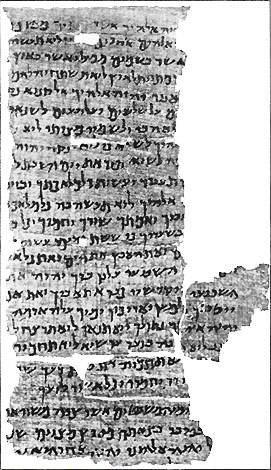
No higher resolution available.

|
This image was uploaded to the shared "Image Pool" and is usable on any CreationWiki site.
Please go to the Pool to edit its description.
|
Summary
The Nash Papyrus, a collection of four papyrus fragments acquired in Egypt by W. L. Nash and first described by Stanley A. Cook in 1903. The fragments were the oldest Hebrew fragments known at that time which contained a portion of the biblical Masoretic text, specifically the Ten Commandments and the Shema Yisrael prayer. The order the commandments listed in the Nash papyrus differs from that of the Hebrew Bible and Septuagint.
Though dated by Cook to the 2nd century, subsequent reappraisals have pushed the date back to the 2nd century BC. In addition to biblical text, it also exhibits a few unique readings. The papyrus was probably copied from a liturgical work.
Reference: David Noel Freedman, The Nine Commandments (Doubleday, 2000) p.87
Copyright status
This image is a slavish reproduction of a centuries-old original of a centuries-old subject. As such it is in the public domain.
Source
Original Source: http://www.jewishencyclopedia.com/images.jsp?artid=192&letter=D&imgid=716
Final Source:Wikimedia Commons
http://commons.wikimedia.org/wiki/Image:2nd_century_Hebrew_decalogue.jpg
File history
Click on a date/time to view the file as it appeared at that time.
| Date/Time | Thumbnail | Dimensions | User | Comment |
|---|
| current | 20:23, 17 November 2008 |  | 271 × 470 (41 KB) | Temlakos | The Nash Papyrus, a collection of four papyrus fragments acquired in Egypt by W. L. Nash and first described by Stanley A. Cook in 1903. The fragments were the oldest Hebrew fragments known at that time which contained a portion of the biblical [[ |
File usage
The following 2 pages use this file:
This file contains additional information, probably added from the digital camera or scanner used to create or digitize it.
If the file has been modified from its original state, some details may not fully reflect the modified file.

